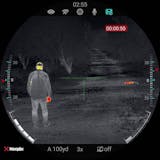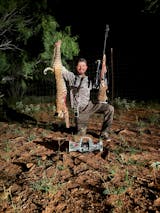
Can Thermal Optics See Through Walls, Trees, and Glass? Demystifying the Technology
Share
Can Thermal Optics See Through Walls, Trees, and Glass? Demystifying the Technology
The world of thermal optics, often referred to as thermal imaging, is a fascinating realm where the invisible becomes visible. This technology, which has found its way into numerous fields, from security and wildlife observation to even gaming, has captivated the public imagination. One question that frequently arises is: Can thermal optics see through walls, trees, and glass? The answer, while intriguing, is not a straightforward yes or no. While thermal optics offer incredible capabilities, their limitations also play a significant role in understanding their true potential.
How Thermal Optics Work: Unveiling the Invisible World
To grasp the capabilities and limitations of thermal optics, we must first understand how they work. The foundation of this technology lies in the detection of infrared radiation, a type of electromagnetic radiation that is invisible to the human eye. Every object with a temperature above absolute zero emits infrared radiation, and the intensity of this radiation is directly proportional to the object's temperature. Think of it as a heat signature that every object, living or inanimate, constantly radiates.
Thermal cameras, the instruments that make thermal optics possible, are designed to capture this infrared radiation and convert it into a visual image. The resulting image, often displayed in a palette of colors, represents the temperature distribution of the scene. Warmer objects appear brighter, while cooler objects appear darker, allowing us to visualize the invisible heat signatures.
The Limits of Thermal Optics: Where the Invisible Remains Hidden
While thermal optics can reveal the invisible world of heat, they are not a magic wand that can see through any obstacle. Certain materials pose significant challenges to thermal imaging, blocking the infrared radiation that thermal cameras rely on. These limitations are crucial to understanding the true capabilities of thermal optics.
-
Walls: A Barrier to Infrared Radiation
Walls, whether constructed from brick, concrete, or wood, act as formidable barriers to infrared radiation. They effectively absorb and reflect this heat signature, preventing it from passing through. This means that a thermal camera will not be able to see through a wall. Instead, it will detect the heat signature of the wall itself, revealing its temperature rather than the objects hidden behind it.
-
Trees: A Dense Network of Obstacles
Similar to walls, trees, with their dense foliage and woody structure, act as obstacles to infrared radiation. The heat signatures detected by a thermal camera will be those of the tree's leaves and trunk, effectively masking any objects hidden within. While thermal optics can be valuable for observing wildlife in trees, they won't allow you to see through the branches to spot hidden animals.
-
Glass: A Transparent Illusion
While glass is transparent to visible light, allowing us to see through windows, it presents a different scenario for infrared radiation. Glass is opaque to infrared radiation, acting as a barrier that prevents this type of radiation from passing through. This means that a thermal camera won't be able to see through windows or other glass barriers. Instead, you will only observe the temperature of the glass itself.
What Thermal Optics Can Detect: Exploring the Visible World of Heat Signatures
Despite their limitations, thermal optics remain a powerful tool for detecting and visualizing heat signatures. They offer a unique perspective on the world, revealing hidden patterns and information that can be invaluable in a range of applications.
-
Living Beings: A World of Heat Signatures
Thermal optics excel at detecting living beings, both humans and animals. This is because warm-blooded creatures emit distinct heat signatures that are readily detected by thermal cameras. These signatures are significantly warmer than their surroundings, making them easily identifiable. This has led to widespread applications in security, where thermal cameras are used to detect intruders or monitor sensitive areas, as well as in wildlife monitoring, where they help researchers track animal movements and behaviors.
-
Heat Sources: Pinpointing Hidden Threats
Thermal optics can pinpoint sources of heat, such as faulty electrical wiring, overheating equipment, or even hidden fires. The ability to detect these heat anomalies makes thermal cameras invaluable for building inspections, where they can help identify potential fire hazards, and industrial maintenance, where they can pinpoint areas of excessive heat that could lead to equipment failure. In firefighting, thermal cameras can help firefighters locate victims trapped in burning buildings and identify the origin of the fire.
-
Temperature Differences: A Window into Heat Dynamics
Thermal cameras can effectively highlight temperature variations within a scene. This makes them ideal for identifying leaks in pipes, where the escaping heat creates a noticeable temperature difference, and heat loss in buildings, where areas of poor insulation can be easily identified. They can also be used to track the movement of heat waves, revealing patterns of thermal energy transfer in the environment.
Conclusion: The Power of Thermal Optics
While thermal optics may not have the magical ability to see through walls, trees, and glass, they remain a powerful tool for understanding the thermal properties of objects and detecting heat signatures. Their applications extend across various fields, offering valuable insights into the invisible world of heat radiation. By understanding their capabilities and limitations, we can effectively harness the potential of thermal optics for various purposes, from enhancing security to promoting energy efficiency and understanding the dynamics of our environment.





